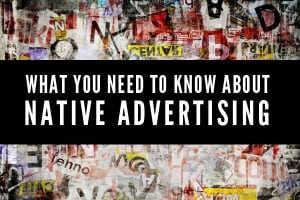
We’re all going “native” now. The Interactive Advertising Bureau Wednesday is releasing a white paper on so-called “native advertising,” or branded content, at the same time that the Federal Trade Commission is starting to hold daylong town hall hearings on the matter. Communicators should pay careful attention.
Native advertising, which contextually melds advertising content to editorial content, has exploded in the last couple years, as the Web has upended traditional advertising spending.
Native social advertising is expected to grow to $4.6 billion in 2017, from $1.6 billion in 2012, according to research firm BIA/Kelsey (per the New York Post).
While native advertising is seen as a way for media companies to generate new revenue, critics say that the trend compromises the integrity of both media companies and brands. But it seems as if native advertising is winning the day.
With integrated communications becoming the norm, PR pros are increasingly being asked to develop and distribute branded content.
In many cases, communicators are working with their ad brethren in developing such content; in other cases (at both the corporate and agency levels), PR pros are creating the content on their own.
With that mind, here’s a refresher on what communicators need to know when crafting branded content, compliments of Sam Ford, director of audience engagement at Peppercomm.
> Consider the level of transparency. Some “native advertising” has gotten a little too “native,” in the sense of forsaking proper disclosure. A range of providers now offers paid links connecting your content to (let’s hope) relevant material elsewhere.
> Consider your audience. The whole concept behind storytelling as a brand is to share content about what your audience wants to know rather than what the company wants to say. A simple test for any content is to take off your PR and marketing shoes and look at the content from the audience’s perspective. Does it focus on issues and subjects that people are talking about outside of your brand?
> Consider the context. You may have the right story to tell, but timing is everything. Is your content being shared at the places where audiences would welcome seeing it? Is it being shared alongside content that you would want your brand to have? Is it being shared in places your audiences populate? Too often, the right content ends up in the wrong context.
What’s your take on PR’s role in developing branded content?
Follow Matthew Schwartz: @mpsjourno1

Pretty vague article. What about Red Bull? How would you define their stance in the traditional media world?
This is simple lying and violates FTC truth in business practices regulations. Some lawsuits are needed to stop this silly idea.
yeah, the fine line between PR and “content marketing” is blurred at best.
Putting transparency concerns aside, if we agree that the proliferation of branded content is here to stay, then brands must shift their approach and thinking to developing and implementing sound content strategies.
In short, they must begin to think and act like publishers. Their aim should be to develop compelling content that is not about them but focused more on the issues and topics that are of importance to the audiences they need to reach. This is easier said than done, especially since most brands are so accustomed to developing traditional marketing content about their products, services and people.
In the end, as Matt points out, it’s a huge opportunity for agencies.
There’s an opportunity for Public Relations but our profession has the most to lose in a world of diminishing media credibility and magnetism. Publishers and ad agencies love it as an alternative revenue stream but if the media ignore the needs of media consumers, short-term interests will be overtaken by even lower circulation, viewership and engagement. While media relations doesn’t “define” public relations, it continues to be an important part of the practice. Subtract editorial integrity from the mix and everyone loses.
It will be interesting to see how the FTC responds (the Commission already regulates advertising to children, tobacco and alcohol, etc.) but does anyone outside our circle of marketers, PR and publishing even care? And what is the public relations community prepared to do to defend strong and independent journalism?
Another term for “native advertising” — pay to play. And that’s just wrong. How can readers trust the media if they suspect coverage is based on advertising purchases? I agree with Brain Molecule: It needs to be stopped, at least in professional, credible media.
Exactly!
Renaming payola to “native advertising” doesn’t make it less sleazy. Is a “Special Advertising Section” header (in the case of a newspaper) enough? Is “The author of this piece is a brand manager for X, who paid Y to be published” too much?
A lot of local newspapers are dying and are desperate to generate revenue, but “native advertising” is just going to be another nail to their coffin: it helps to destroy their credibility.
Miguelggarcia – I couldn’t agree more.